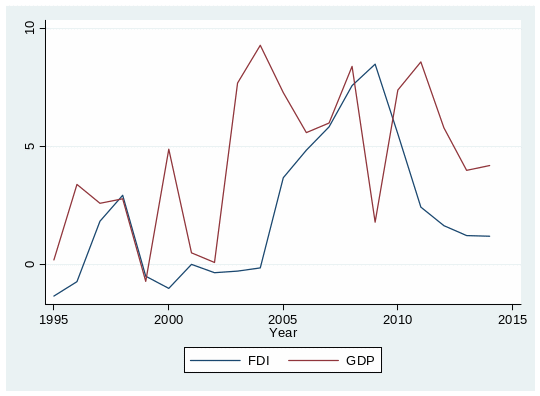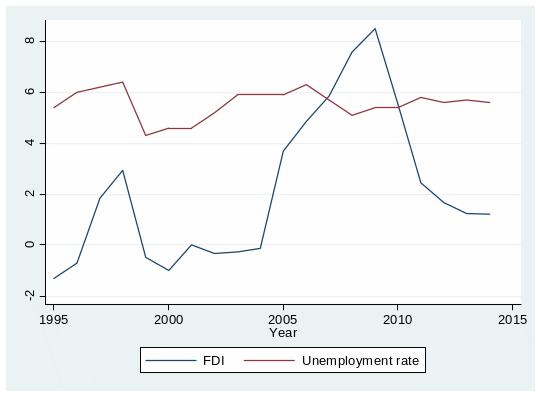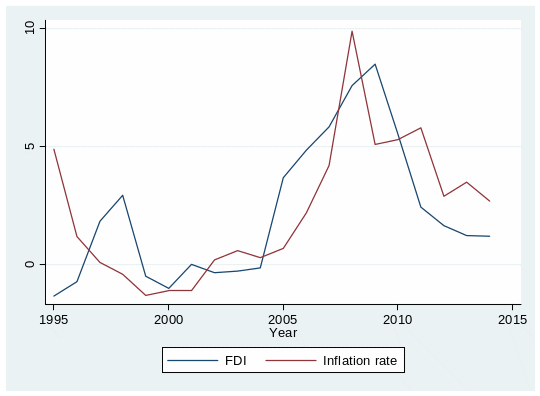Introduction
FDI is a form of “investment inflows that involve obtaining a lasting interest by a resident entity of one economy in an enterprise that is resident in another economy” (Reinert 2011, p. 67). The lasting interest means that a long-term relationship exists between a foreign investor and a local enterprise. It also means that the investor has significant influence or control over the local firm. FDI is expected to spur economic growth through the creation of job opportunities, an increase in exports, and access to foreign capital. This paper will analyze FDI in Saudi Arabia. It will begin with a discussion on the main theories that explain FDI. This will be followed by an analysis of the costs and benefits of FDI in Saudi Arabia.
Theories that Explain FDI
The Product Lifecycle Theory
The main argument of this theory is that the decision to undertake FDI is determined by the various stages of the product lifecycle rather than the advantages in the host country (Chah 2012). Newly invented products are often manufactured in the domestic economy. This decision is informed by the need to centralize production, distribution, as well as research and development activities to reduce operating costs. Proximity to potential customers is another factor that encourages domestic production at the early stages of the product lifecycle.
As a product approaches the maturity stage of its lifecycle, it experiences high demand and popularity in foreign markets (Chah 2012). This motivates the producer to export the product. Firms in the foreign market respond by copying or providing similar products at a low price to undercut the exporter. Thus, the exporter (original producer) must undertake FDI by establishing overseas production units to reduce costs. Increased competition at the maturity stage leads to product standardization (Chah 2012). As a result, the original producer loses a monopoly in the production and supply of the product. This means that production must shift to developing countries that have cheap labor to reduce production costs.
The main strength of this theory is that it explains the flow of FDI from developed countries such as the US that have high labor costs to developed countries. However, it fails to explain the causes of FDI outflows from developing countries such as China to developed nations.
Oligopolistic Reaction Theory
This theory explains FDI as an oligopolistic reaction in which companies imitate their competitors’ FDI decisions to remain competitive. An oligopolistic market is characterized by a few firms that can easily determine the effect of their actions on the competitiveness of their rivals (Chah 2012). This means that firms in an oligopolistic industry are interdependent in terms of strategy formulation. The independence often leads to a behavior pattern in which every firm must react to or counter its rivals’ moves. Thus, a decision by one firm to join a foreign market through FDI will force its rivals to do the same. In this context, the decision of the follower is motivated by the need to prevent its rival from accessing resources and gaining market share in a foreign market at its expense.
The theory provides a logical explanation of the tendency of firms to imitate their rivals’ FDI decisions. However, it fails to explain the factors that motivate the first firm to embark on FDI (Nayak & Choudhury 2014). It also fails to explain why the first firm and its competitors ignore alternative ways of serving foreign markets such as exporting.
The Eclectic Paradigm
In this theory, firms embark on FDI only if three conditions are met. The conditions include the following. First, a firm that intends to undertake FDI should outperform its rivals in terms of asset ownership advantages. Second, the firm should be able to benefit by exploiting its ownership advantages internally rather than through market mechanisms such as licensing or franchising (Nayak & Choudhury 2014). Third, the firm should enjoy location advantages by employing its own advantages in a foreign market.
Ownership advantages are obtained from firm-specific characteristics such as the ability to access superior technology, good corporate governance, and adequate capital (Reinert 2011). These advantages are expected to improve the competitiveness of a company by reducing its production costs in a foreign market. Location advantages are important because they improve the ease of product distribution and access to raw materials. This enables companies to reduce operating costs. Exploiting ownership advantages internally is also an important strategy because it ensures effective control. It also reduces the risk of providing proprietary knowledge to potential competitors (Nayak & Choudhury 2014). In addition, it enables multinational corporations to avoid the uncertainties associated with imperfect markets.
Industrial Organisation Theory
This theory is based on the premise that foreign firms are inherently disadvantaged when competing with local firms. For instance, foreign firms may face cultural and legal barriers. They are also likely to face foreign exchange risks (Reinert, 2011). This means that FDI is only profitable if companies are able to counter the disadvantages that they face in foreign markets. Foreign companies must have some form of market power in order to succeed in overseas markets. They can derive market power by developing superior technologies, strong brands, and hiring talented employees.
Foreign companies with advanced technologies are likely to overcome competition through product and process innovation. Generally, innovation improves competitiveness by reducing costs and facilitating the production of products that satisfy market needs. The theory assumes that markets are imperfect. Thus, companies “can take advantage of their market power to reap huge profits by investing abroad” (Reinert 2011, p. 98). For example, access to superior production technologies allows firms from the US and Europe to compete effectively in countries such as China and India, where they face significant cultural challenges.
Internalization Theory
This theory focuses on the industry-level and firm-specific factors that determine FDI. It postulates that profit maximization can be achieved in an imperfect market (Chah 2012). The theory also postulates that the market for intermediate products can be ignored if it is imperfect. In this case, a company is expected to create its own internal intermediate goods market to gain competitive advantages in a foreign country. This process (internalization of markets) leads to the creation of transnational corporations (Nayak & Choudhury 2014). High transaction costs can prevent a company from selling its inputs or technology to other firms. However, it can benefit from transferring the technology or input to its subsidiaries. This leads to FDI as companies establish foreign subsidiaries to use their new technologies or inputs.
Benefits of FDI
FDI and GDP Growth
Figure 1 illustrates the relationship between FDI and GDP growth in Saudi Arabia. The relationship seems to be positive in general. However, the positive relationship is not consistent between 1998 and 2000, as well as 2008 and 2010.

From 1998 to 2000, economic growth in Saudi Arabia increased rapidly because of high oil demand in countries such as China and Japan. High international oil prices also increased revenue from oil exports (Alshehry 2014). Nonetheless, FDI was decreasing due to the break of the dotcom bubble that led to an economic downturn in the US and Europe. The negative correlation between FDI and GDP from 2008 to 2010 can be explained by the fact that the global financial crisis led to a significant reduction in oil exports. This reduced GDP growth despite the increase in FDI.
The positive correlation means that FDI contributed to increased economic growth in Saudi Arabia. FDI contributed to economic growth through the development of the oil industry. Companies from the US and the UK have helped the country to increase oil exports through technology transfers, which led to increased oil production (Chah 2012). FDI also contributed to GDP growth through capital accumulation. Foreign institutional investors invested in huge financial capital in Saudi Arabian companies. The resulting increase in productivity led to improved economic growth. FDI also contributed to GDP growth through knowledge transfer. Foreign companies often train host country nationals to improve their productivity, which in turn boosts economic growth.
FDI and Exports
Table 1 compares changes in FDI with changes in exports as a percentage of GDP in Saudi Arabia. FDI increased from -0.71% in 1996 to 2.94% in 1998. By contrast, exports declined from 40.26% to 29.84% (World Bank, 2015).
Table 1: FDI and exports.
This short-term negative relationship can be explained in part by the Asian financial crisis that occurred in the late 1990s. The crisis led to a reduction in oil demand in Asian economies, thereby reducing Saudi Arabia’s exports. FDI, on the other hand, was increasing due to the rapid economic growth that occurred in Europe and the US before the break of the dotcom bubble (Chah 2012).
The increase in FDI was not sufficient to offset the reduction in exports since oil is the main export commodity in Saudi Arabia. According to table 1, both FDI and exports increased from 2002 to 2008. The decline in FDI from 2011 to 2014 was accompanied by a decline in exports. These trends show that FDI has a positive impact on exports in Saudi Arabia. FDI increased productivity in Saudi Arabia, thereby increasing exports.
FDI and Employment
The relationship between FDI and the unemployment rate in Saudi Arabia is shown in figure 2. The figure shows that both FDI and the unemployment rate increased from 1995 to 1998. This means that FDI led to an increase in the unemployment rate.

One of the factors that explain this relationship is that foreign companies are likely to increase the unemployment rate in the short run through restructuring programs (Chah 2012). Figure 2 also shows that the relationship between FDI and unemployment rate was negative from 1999 to 2014. This implies that FDI had a long-term positive effect on employment. Specifically, FDI led to the creation of new job opportunities, which in turn reduced the unemployment rate.
Costs
Inflation Rate
An increase in the inflation rate is one of the negative effects of FDI in Saudi Arabia. Figure 3 shows that inflation and FDI have a positive correlation in the country. This means that an increase in FDI leads to an increase in the inflation rate and vice versa.

FDI can increase the inflation rate through its positive impact on GDP growth. An increase in economic growth is often accompanied by a high demand for goods and services.
This forces producers to increase prices in order to ration goods and services whose supply is limited, thereby increasing the inflation rate (Alshehry 2014). However, a reduction in economic growth due to low FDI leads to a decline in aggregate demand. An economic downturn reduces the inflation rate since producers must reduce their prices in order to sell all their goods and services. A high inflation rate is undesirable because it reduces purchasing power. The resulting reduction in aggregate consumption is likely to reduce economic growth, thereby increasing poverty (Alshehry, 2014).
Competition
FDI has also had a crowding-out effect in Saudi Arabia in several ways. To begin with, domestic firms in industries such as oil, manufacturing, and banking have not been as competitive as their foreign counterparts. Foreign firms have taken advantage of their efficiency and superior technologies to produce high-quality products at a low cost, thereby gaining market share at the expense of local firms (Alshehry 2014). The multinationals in Saudi Arabia have access to global goods and capital markets. However, most local firms depend only on the domestic market. Increased borrowing by foreign firms in Saudi Arabia has increased the cost of credit. This has significantly reduced the ability of local firms to raise capital to expand their operations in order to compete with multinationals.
Conclusion
Several theories have been developed to explain FDI in terms of the factors that encourage transnational firms to invest in foreign markets. Saudi Arabia is one of the developing countries that have greatly benefited from FDI. Increased FDI led to improved economic growth and low unemployment rate. It also increased exports in the country. However, FDI increased the inflation rate in the country. It also increased competition in Saudi Arabia. Thus, the government should focus on reducing the negative effects of FDI in order to realize its full potential.
References
Alshehry, A 2014, ‘Foreign direct investments and economic growth in Saudi Arabia: a co-integration analysis’, Development Country Studies, vol. 5, no. 6, pp. 69-79. Web.
Chah, E 2012, Foreign direct investment in Saudi Arabia: a case study of two Swedish firms, Linnaeus University, Kalmar. Web.
Nayak, D & Choudhury, R 2014, A selective review of foreign direct investment theories, ESCAP, Bangkok. Web.
Reinert, K 2011, An introduction to international economics, Cambridge University Press, Cambridge. Web.
World Bank 2015, Foreign direct investment net inflows. Web.